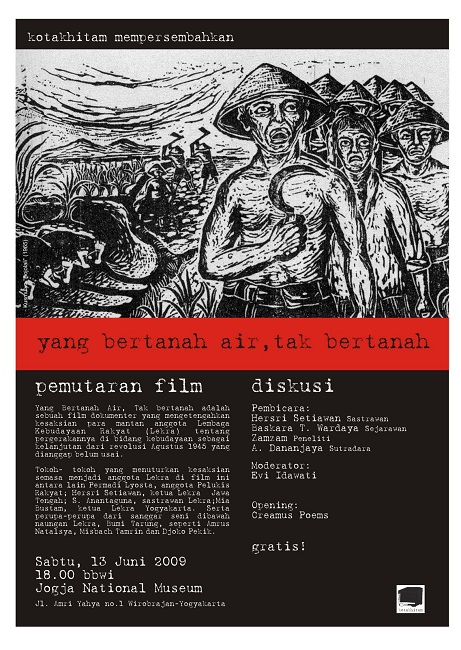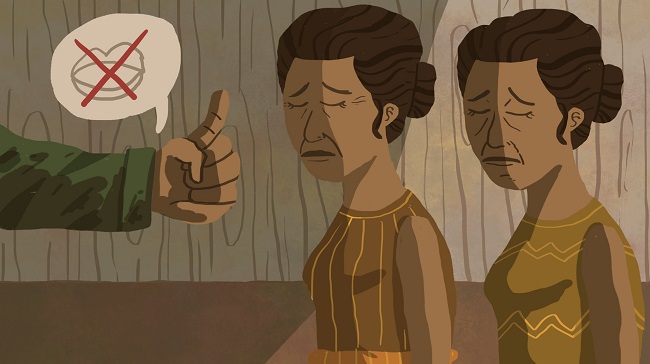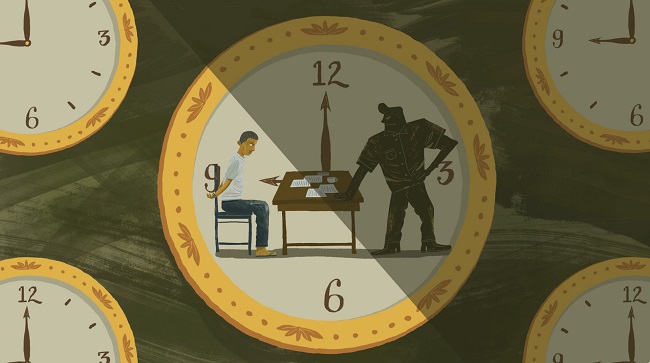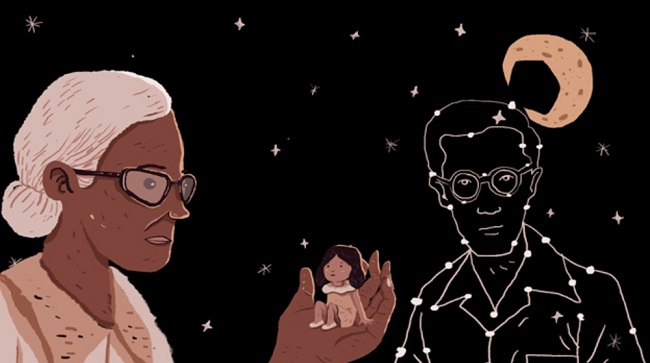Jemma Purdey interviews filmmaker Kartika Pratiwi, who represents a generation of Indonesians using the screen to depict their own versions of Indonesia’s past and hopes for its future
Jemma Purdey & Kartika Pratiwi
As a filmmaker, what kinds of stories are you drawn to telling and why?
I was raised in a family and society where discussing the past is somewhat taboo. Growing up I took everything I read and heard to be true because they said it was the truth. My family is Chinese Indonesian. Our position as a minority meant I was brought up to believe that speaking out on sensitive issues was dangerous and not allowed. Up until that point, I had not had the opportunity to meet many people, read many books, or learn about the lives of others. At university I studied history and a cultural studies, which gave me the opportunity to meet a lot of different people, including survivors of past human rights abuses. These encounters changed my life and brought me to my lifetime commitment to work in the field of human rights. Since that time, I have been slowly collecting stories, and archives from survivors of human rights abuse.
The stories I heard as a young research student were stories I'd never heard before, stories that were left out of history, but also stories that are remembered by those who experienced these events. By figuring out what lessons can be learned from survivors’ stories, I hope to close this gap through visual storytelling. My work proposes a survivor-centred approach. I believe that survivors should have a say in how their stories are recounted and recorded.
You are one of the founders of kotakhitam Forum. Tell us about the organisation and what motivated you and your colleagues to set it up?
We established kotakhitam Forum in 2008, with only six of us. We made our first video about LEKRA or Lembaga Kebudayaan Rakyat (Institute for the People's Culture), whose members were also survivors of human rights abuses in 1965-1966. We believed that ‘voice’ can speak to power, and is a literal weapon of evidence against historical erasure and social analysis that fails to consider the experiences of individuals and communities on their own terms. kotakhitam Forum provides a safe space for excluded, outcast, and marginalised communities (especially past human rights abuse survivors), to have their voices heard. Recognising the particular power of visual narratives and also the reality that many survivors were already elderly, we rushed to gather as many testimonials, footage, and other visual evidence as we could before time ran out. The seemingly simple process of gathering records, sometimes called archiving with the purpose of confirming the experiences of survivors who have been silenced, erased, or marginalised, is also highly political. For many community archive practitioners, archival collecting is more than just preserving the past. We were all self-taught in film production and distribution but we realised we still had stories to document and share with the next generation.
kotakhitam Forum have produced several films related to 1965. Why choose this period of Indonesia’s history in particular?
Before reformasi in 1998, Indonesians believed what the New Order government said about this bloody and divisive period in our nation's past. Since the government controlled the history books, history teachers in Indonesia had to teach the official point of view. Every year students also had to watch a film commissioned by the government titled, Pengkhianatan G30S/PKI (The Betrayal of the 30th September Movement/Indonesian Communist Party). During the New Order, this film was screened on 30 September every year. It depicts the official narrative that formed the pretext for the mass killings of communists and others, that followed. Film experts say that this movie is a 'documentary-drama'. The script and pictures in this film depict communists, Gerwani (Indonesian Women's Movement), and communities run by the Communist Party (PKI) as evil people.

After the New Order regime fell in 1998, people became interested in finding out the truth about the human rights abuses that took place in 1965-66, beyond the standard account. A range of documentaries and books offered an alternative way of talking about history. These new tools forced some communities, schools, and history teachers to be more open to different ways of looking at the past. But public discussion about alternative versions of the past hasn't always made a difference. Many Indonesian teachers still use the same books they used during the New Order era, as if they can't let go of the trauma.
Like other Indonesians our age, a group of us at kotakhitam Forum had grown up being forced to watch this propaganda film. When we were lucky enough to have the opportunity to meet survivors who were ready to tell us their side of the story, we agreed that these stories should be told to as many people as possible. We felt bad that we used to believe the official version, which did not take their experiences into account; and we understood that these events in our country’s past were the source of other violence that had occurred since. Until now, and regardless of Joko Widodo’s acknowledgement of the events of 1965-66 in January 2023, there has been no recognition of the human rights abuses, nor reconciliation, and the social stigma towards survivors remains very strong.
Your film A Daughter’s Memory is a short animation documentary telling the story of and narrated by, Svetlana, daughter of senior PKI member Njoto. Can you tell us about the process of making this film and the involvement of Svetlana in the production itself?
The short animation video starts with a game of Scrabble. One night, three siblings are playing Scrabble in a house in Gunung Sahari. Their situation suddenly changes when a military truck pulls up to their house. Captain Suroso walks into the house, takes over the Scrabble board and puts the word 'Njoto' on it. This is the name of one of the central committee leaders of the Indonesian Communist Party (PKI). Njoto is also the father of these children, giving this historical event another side. It ties national crime to a family's memory by using Scrabble as a trick. The film tries to show the violence of 1965–1966 from a different point of view by telling the story of a young girl who lost her father. It's a national tragedy, but it's also something that happened to a small girl. It's not just about sadness and loss; it's also about fighting and getting past fear.
The stories depicted in the film are those of Svetlana Dayani Njoto, one of Njoto's daughters, who worked hard with us on the project. Through Svetlana's stories, Njoto, who is known in Indonesian history as a leader of the PKI, becomes just another person, a gentle father who taught his daughter how to use a typewriter. But Svetlana's story is also full of details about the terrible things that happened in 1965 and 1966. She talks about what it was like to be locked up in jail with her mother and brothers. She remembers seeing people who had been brutally questioned every day being dragged back to their cells covered in blood. In the mornings when the interrogation room wasn't being used, Svetlana was often directed to clean it up. Here, she saw signs of torture, like the tail of a stingray and blood on the floor.
The tragedy of 1965 was a situation where the government's version of events was presented in an effort to suppress the local population, the press, and the educational establishment. Personal accounts from living witnesses, like the one Svetlana provided, appear to be suppressed. A Daughter's Memory comes into play at this point. Its objective is to share the perspective of the survivor and prevent something similar from occurring in the future.
Svetlana was involved in every aspect of the production. We wanted to approach this production from a survivor's perspective since we think that in the end, the film belongs to her and not just to us.
Did you need to take particular precautions when you were making and distributing A Daughter’s Memory? If so, what did you do? Have you been able to bring it to a wide audience inside Indonesia?
Yes, advocacy and campaigning on 1965 issues contains the most risks due to some sections of the community being particularly invested in its official narrative and the power that has come to them as a result. Because the stigma about 1965 remains, we were concerned that a campaign to promote and distribute the film on social media could lead to a backlash on those platforms. As a consequence, we decided to keep the event fairly low-key, protect identities where requested and involve as many allies and known and trusted parties as possible. For us this was our first experiment in this area and we wanted to tread carefully. In addition, the network and team who worked on this film and its distribution and socialisation developed a security assessment as part of its project plan.
You were involved in making films with Asia Justice and Rights (described elsewhere in this edition) focused on survivors of human rights abuses in Aceh and Timor Leste. They are also animated short documentaries. What reception have these films had from audiences, particularly young people?
Asia Justice and Rights (AJAR) collaborated closely with local organisations in Aceh and Timor-Leste to produce their project ‘Making Right to Truth Tangible’. Its goal is to record the testimonies of victims, encourage discussion and work with the local government to redress historical human rights breaches.

Konta-sai and 8.45 are two animated documentary shorts that we created as media to support survivors who were speaking out about their experiences and life journeys, as well as to create a space for self-reflection and the mutual support. Ultimately, we hope the films would aid them in the fight against the pervasive impunity for these historical human rights violations. The animated short films Konta-sai and 8:45 are based on real events that took place during times of violence in Aceh (Indonesia) and Timor-Leste, respectively. Narrated by the survivors' themselves, they provide every detail in the documentaries in their own voice.
As a film educator as well as filmmaker, you’ve also worked with organisations in West Papua and others fighting for their human rights. In what ways is film/video a useful tool for groups like these?
Digital storytelling and video are well-known strategies for dismantling and subverting dominant narratives. We think that using these kinds of tools could also help those who fight for the rights of Papuans, who, despite having a lot of natural resources, live in poverty, face discrimination, and have their human rights violated on a regular basis. Papuans are currently facing many serious problems, which are not being paid enough attention from both inside and outside Indonesia. These issues include discrimination, corruption among officials, conflict over mining operations, illegal logging, palm oil development, high unemployment, and health problems, among many others.
Technology use in West Papua is still in its early stages, but it has already started to fill the vast information gaps in the region, and give Papuans the chance to make and share their own news. Local activists are using video more and more to get their message out. There are a lot of ways to use video and tactical media sharing together. Getting national and international attention through video has the potential to aid Papuans in their pursuit of justice for human rights violations. The least we can do is to maintain these communities at the forefront of our archival efforts, given the atrocities they have endured and their continued fight for justice and accountability.
Tell us about the work you are now doing at WITNESS where there is, perhaps, less of an emphasis on re/presenting the past, and more on the role of video in documenting and archiving current human rights abuses. Is that correct?
Yes, WITNESS uses video and technology to protect and defend human rights worldwide. Working closely with vulnerable and marginalised communities and systems-level stakeholders like technology companies and international justice bodies, WITNESS fills crucial gaps in the use of video and technology for human rights, ensuring that videos can be trusted and verified, activists can stay safe and manage risk, evidentiary videos can be found amidst mass volume, and movements and groups can use visual storytelling strategically and impactfully.
Our work is grounded in the belief that equipping affected communities with the skills to use video and technology for human rights safely, ethically, and effectively provides the foundation for an informed and just and equitable society. We are also committed to ensuring that the needs and challenges of these communities are better integrated into popular technology systems and tools, ensuring that at-risk users can more safely and effectively use these tools to defend their rights.
You have been involved in film activism in Indonesia and around the world for over a decade now. Many challenges remain for activists in Indonesia including the Electronic Information and Transactions Law (ITE), for example. But what impact do you think film activism is having and why? What is its potential for having an even greater impact in the future?
The Electronic Information and Transactions (ITE) Law should be abolished. It is a terrible law that allows the nation to operate with impunity and is contributing to the shrinking of civil space and restricting freedom of speech in Indonesia. The EIT Law's provisions are so unclear that they have been used as a basis for filing police complaints and making arrests related to a wide range of concerns, including sexual immorality, defamation and hate speech. As filmmakers who focus on sensitive themes such as human rights and who work with marginalised groups, the law is very threatening. It has been used to prosecute, and in many cases convict, activists and journalists who dare to speak about others versions of what-they-call-truth.

Just as video and digital platforms have grown crucial to human rights organising, advocacy, and day-to-day communications, the same can be said at the opposite end of the spectrum, where there has been a rise in the use of technology to monitor and harass human rights activists. Human rights filmmakers/journalists/activists are targeted because they question strong interests, expose injustices, and defend victims of human rights crimes.
We use film to fight for free speech, to speak out against what has been suppressed, and to fight against impunity for what has happened in the past. The process of filmmaking is in itself totally safe, as long as you do your own risk assessment and involve your subjects from the beginning of the process. However, when it comes to distribution, in recent times this space has been shrinking, including online. To combat this, one way forward is to engage in a targeted and direct way with groups within the community, such as young people, academics, and the survivors themselves.
Kartika Pratiwi is a communications and development specialist with 15 years of experience using visual storytelling and collective memory for social change. Currently, she is working with WITNESS as Programmatic Communications Coordinator (Asia-Pacific). Previously, she worked with EngageMedia and Asia Justice and Rights (AJAR), non-governmental human rights organizations, committed to the promotion and protection of human rights in the Asia-Pacific region. Jemma Purdey is Coordinating Editor of Inside Indonesia and Director of ReelOzInd! Australia Indonesia Short Film Festival.












